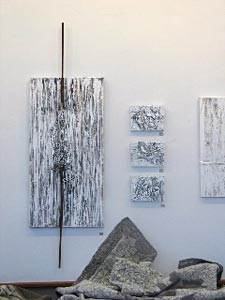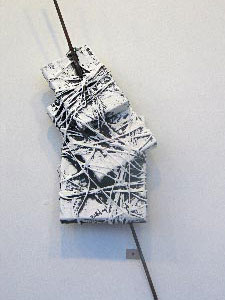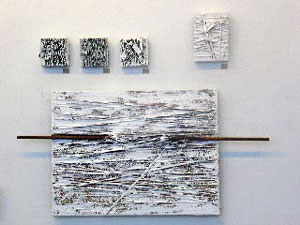Sue tells us about her new work . . .
 Transformation is a common theme in nature from the primal mysteries of pregnancy and birth to miraculously germinating seeds from the embers of a forest fire. But the wonders of transformation are not always consistent with preconceived notions of beauty. My new work bears witness to the regenerative power present in post-industrial waste products, scraps and discards. I have been moved to explore my niche in the incessant process of transformation, manifest even in places of asphalt, concrete, toxins and residues, rusted nails, twisted wire, smashed glass and salvaged rebar.
Transformation is a common theme in nature from the primal mysteries of pregnancy and birth to miraculously germinating seeds from the embers of a forest fire. But the wonders of transformation are not always consistent with preconceived notions of beauty. My new work bears witness to the regenerative power present in post-industrial waste products, scraps and discards. I have been moved to explore my niche in the incessant process of transformation, manifest even in places of asphalt, concrete, toxins and residues, rusted nails, twisted wire, smashed glass and salvaged rebar.
 I've re-purposed, re-used and re-imagined materials and found objects, just as I have done in the past with fiber in my textile work. Friends allowed me to rummage through their trash, junk, rejects. Instead of buying new art supplies, I created my work from filings, cuttings, shavings, broken parts and manufacturer's debris, materials typically considerd worthless. I never had to pay for these supplies - in fact, people were glad to have me haul their unwanted scraps away. I even used old canvases and other pieces from art projects that I had abandoned.
I've re-purposed, re-used and re-imagined materials and found objects, just as I have done in the past with fiber in my textile work. Friends allowed me to rummage through their trash, junk, rejects. Instead of buying new art supplies, I created my work from filings, cuttings, shavings, broken parts and manufacturer's debris, materials typically considerd worthless. I never had to pay for these supplies - in fact, people were glad to have me haul their unwanted scraps away. I even used old canvases and other pieces from art projects that I had abandoned.
One of the ironies of the modern world is that our garbage lasts 500 years, forever for all intents and purposes. Mountains of unmindfully processed materials are produced - our landfills are now visible from space. On the most literal level, my work responds to this phenomenon through "up-cycling," using salvaged materials in new ways. The resulting works are as much tactile as visual, combining the rough/raw with the fragile/muted. This contrast or tension between combinations of materials is always at the heart of my work. Most importantly, my new work has been a kind of subtle alchemy for me, leading to a significant evolution and transformation of my vision.
THE WHITE WALL SERIES
Heart-strung like a harp
Pierced again by love's arrow
Framework of a loom
These pieces were created by wrapping my old canvases with yards of twine (hemp, silk, linen and cotton elastic). Some integrate salvaged steel. The surface treatments utilize clay and acrylic paint. As always with my work, texture rules. The back of each piece reminds me of my years in theatre, where you literally had to "know the ropes," like the rigging of a mighty ship, that made everything happen. The audience had no idea.


 Transformation is a common theme in nature from the primal mysteries of pregnancy and birth to miraculously germinating seeds from the embers of a forest fire. But the wonders of transformation are not always consistent with preconceived notions of beauty. My new work bears witness to the regenerative power present in post-industrial waste products, scraps and discards. I have been moved to explore my niche in the incessant process of transformation, manifest even in places of asphalt, concrete, toxins and residues, rusted nails, twisted wire, smashed glass and salvaged rebar.
Transformation is a common theme in nature from the primal mysteries of pregnancy and birth to miraculously germinating seeds from the embers of a forest fire. But the wonders of transformation are not always consistent with preconceived notions of beauty. My new work bears witness to the regenerative power present in post-industrial waste products, scraps and discards. I have been moved to explore my niche in the incessant process of transformation, manifest even in places of asphalt, concrete, toxins and residues, rusted nails, twisted wire, smashed glass and salvaged rebar.
 I've re-purposed, re-used and re-imagined materials and found objects, just as I have done in the past with fiber in my textile work. Friends allowed me to rummage through their trash, junk, rejects. Instead of buying new art supplies, I created my work from filings, cuttings, shavings, broken parts and manufacturer's debris, materials typically considerd worthless. I never had to pay for these supplies - in fact, people were glad to have me haul their unwanted scraps away. I even used old canvases and other pieces from art projects that I had abandoned.
I've re-purposed, re-used and re-imagined materials and found objects, just as I have done in the past with fiber in my textile work. Friends allowed me to rummage through their trash, junk, rejects. Instead of buying new art supplies, I created my work from filings, cuttings, shavings, broken parts and manufacturer's debris, materials typically considerd worthless. I never had to pay for these supplies - in fact, people were glad to have me haul their unwanted scraps away. I even used old canvases and other pieces from art projects that I had abandoned.
